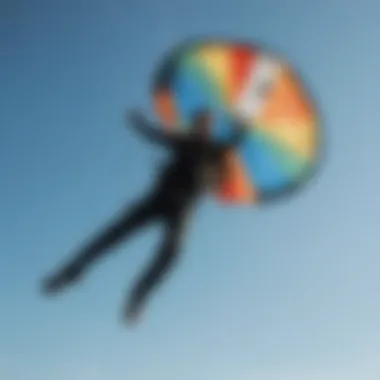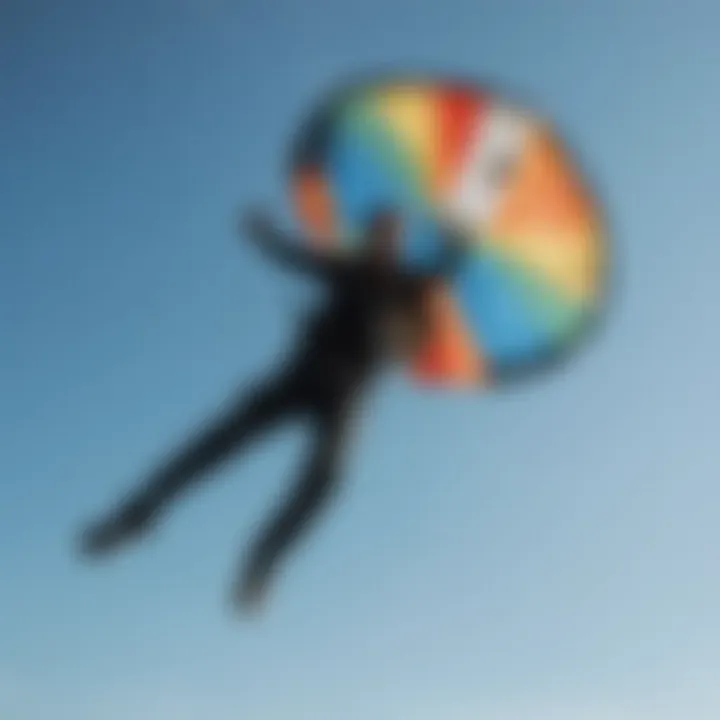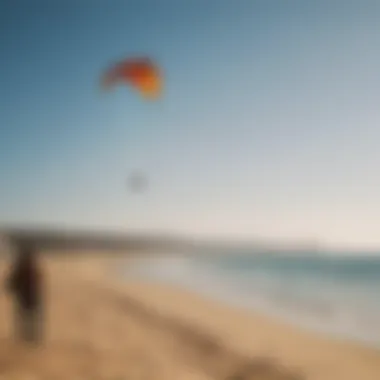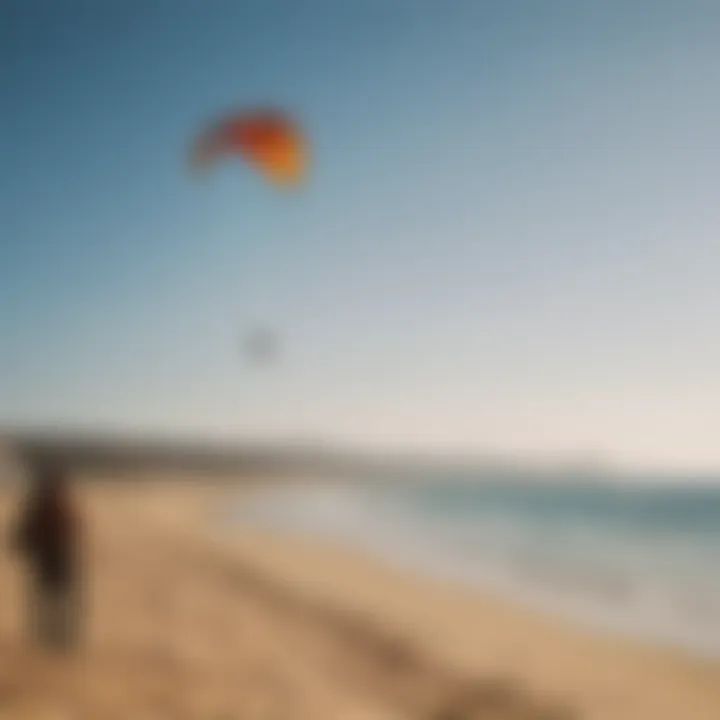Mastering Kite Tricks: A Guide for Avid Flyers


Intro
Kite flying is not just a leisurely activity; it's a vibrant sport that offers a mix of thrill and creativity. For many enthusiasts, mastering kite tricks transitions it from mere flight into an expressive art form. Whether you’re a novice just getting familiar with the strings or a seasoned pro looking to expand your repertoire, understanding the various techniques and skills is crucial. This guide seeks to uncover the ropes of kite tricks, analyzing everything from the basics to advanced maneuvers. By improving your skills, not only do you sharpen your physical capabilities, but you also deepen your appreciation for the intricate dance between kite and wind.
Techniques and Skills
Understanding kite maneuvers is important for those wanting to elevate their game. There’s much to consider, from fundamental practices for beginners to advanced techniques that challenge even the most experienced kite flyers. For anyone serious about kiting, recognizing the nuances of each technique can make all the difference.
Fundamental Techniques for Beginners
Starting with the basics, it's essential for beginners to become familiar with fundamental techniques that lay the groundwork for more complex tricks. Here are a few key ones:
- Takeoff: Simple yet fundamental, the takeoff is about getting your kite into the air smoothly. Pick a day with stable wind conditions; this makes it easier to control your kite.
- Stall: Practicing the stall technique, where the kite momentarily halts its movement in the air, is vital. Get a feel for your kite’s control before attempting more complex tricks.
- Figure Eight: This is one of the basic patterns you can draw in the sky with your kite. It helps you practice steering and controlling the kite’s movement under changing wind conditions.
These fundamental steps will not only enhance your control over the kite but also build your confidence as you progress to more intricate tricks.
Advanced Skills for Experienced Athletes
For those who have already grasped the fundamental skills, mastering more complex maneuvers can open a whole new dimension of kite flying. These advanced techniques require an understanding of dynamics in wind conditions and intricate handling of kite gear. Here are some skills to focus on:
- The Dive: This technique involves diving your kite at an angle and then pulling it up. It's exhilarating but demands precise control to avoid crashing.
- The Backspin: A visually stunning trick that flips the kite on its back and spins it in place, creating a dynamic display. This requires savvy handling and an understanding of your kite's response to wind.
- The Axel: An exciting trick where the kite performs a flip and rotates 360 degrees. Timing is crucial for a successful execution of this jaw-dropping maneuver.
These advanced tricks transform the flying experience into a breathtaking display of dexterity. However, safety remains paramount to ensure not just enjoyment but also the well-being of all participants.
Safety and Gear
When engaging with kite tricks, thorough preparation involving both safety measures and gear selection is non-negotiable. The combination of knowledge and the right equipment can be the difference between a thrilling experience and an unfortunate incident.
Essential Safety Measures in Watersports
Much like other outdoor activities, there are vital safety precautions for kite flying that enthusiasts must follow:
- Know Your Surroundings: Always be aware of wind conditions and avoid flying in areas with power lines or other hazards.
- Use a Spotter: Having someone by your side can help keep track of the kite’s position, especially during complex maneuvers.
- Wear Proper Safety Gear: Consider safety measures like helmets and protective eyewear, particularly when practicing tricks or flying in crowded areas.
Gear Reviews and Recommendations
Investing in quality gear can enhance the overall kite-flying experience. Some brands stand out for their reliability and performance. It's essential to research various options before making a purchase. Here are popular considerations among kite enthusiasts:
- Peter Lynn Kites: Known for their durability and adaptability, perfect for both beginners and experts.
- HQ Kites: Offers a wide range of kites suited for various conditions and skill levels.
- Sullivan Kites: Recognized for excellent performance in trick flying, particularly for advanced users.
Choosing reliable gear and applying sound safety practices creates a foundation for a richer experience while exploring kite tricks. As you develop your skills, embrace the learning process, and enjoy the evolution of your kite-flying journey.
Intro to Kite Tricks
The art of kite flying transcends mere leisure; it embodies a blend of skill, precision, and exhilarating freedom. Kite tricks stand out as a thrilling aspect of this captivating pursuit, allowing enthusiasts to showcase their prowess and creativity in the sky. Within this section, we'll delve into the fundamentals of kite tricks, exploring why they are not only vital for personal growth within the sport but also crucial for maximizing the joy of kiting.
Understanding kite tricks equips kite flyers with the ability to maneuver their kites through the sky in ways that can astonish onlookers and elevate their flying experience. Benefits include improved control of the kite, enhanced awareness of wind dynamics, and a greater sense of accomplishment when mastering new maneuvers. Engaging in kite tricks fosters focus, as it requires the flyer to be in tune with the wind and their equipment.
"The world of kite tricks is a playground where each maneuver tells a story of skill and imagination."
Moreover, safety considerations come hand-in-hand with this adventurous path. By understanding the nuances of various tricks, flyers can navigate potential pitfalls and take calculated risks that enhance their experiences rather than endanger them. Thus, the introduction to kite tricks lays the foundation for a rewarding journey in the world of kiting.
Understanding the Basics of Kiting
To embark on this thrilling adventure, it’s imperative to grasp the basics of kiting. The first step involves familiarizing yourself with the kite itself. Different types of kites possess varying characteristics, which can significantly influence how they respond during tricks.
For instance, delta kites are known for their stability, making them ideal for beginners seeking to perform basic maneuvers. Once a kiter becomes more experienced, they might shift towards stunt kites or foils that allow for more intricate tricks. Mastery over the basic launch and hover techniques is essential, as these foundational skills will serve as the building blocks for more complex maneuvers.
Types of Kites Used in Tricks
Selecting the right type of kite is fundamental for executing tricks effectively. Each kite offers its unique attributes that can either support or hinder a flyer's ability to perform various tricks. Here’s a breakdown of popular kite types used in trick flying:
- Stunt Kites: Designed for performance with dual or quad lines, these kites allow for dynamic maneuvers and precision flying.
- Foil Kites: Often used in kiteboarding, these kites are versatile and perform well across varying wind conditions, making them perfect for tricks that require aggressive air movement.
- Box Kites: With their unique shape, box kites offer stability and can maintain their position in gusty winds; they can add a different flair to kite tricks.
By understanding the strengths and limitations of these kites, kite enthusiasts can optimize their experience and select the right equipment for their desired tricks.
Foundational Kite Tricks
Mastering the foundational kite tricks is crucial for both budding enthusiasts and seasoned flyers. These tricks serve as building blocks; without them, the journey into more intricate maneuvers can quickly become daunting. It’s similar to learning to walk before you can run. Getting these foundational skills down solidly ensures safer, more enjoyable sessions on the field.
Here are some specific elements and benefits of focusing on foundational kite tricks:
- Skill Development: These basic tricks build dexterity and control, establishing a strong base. Skills acquired through these maneuvers often translate to more complex tricks later on.
- Confidence Building: Successfully completing foundational tricks can boost your confidence, encouraging you to push your limits and try new things.
- Understanding Aerodynamics: Many foundational tricks showcase the principles of lift and drag in action, providing valuable insights that are crucial in advanced techniques.
- Safety Awareness: Learning these tricks reinforces the importance of safety protocols, an often overlooked aspect particularly with newcomers.
When delving into each foundational trick, it's necessary to master each step before moving on. Let’s explore some essential foundational tricks that will set the stage for your kite-flying journey.
The Basic Launch
The basic launch is the first hurdle every kite flyer must overcome. It may appear straightforward, but the execution is critical. Proper launch techniques ensure that the kite gains enough altitude and speed to maintain stability in the air.
To execute a successful launch:
- Setup: Ensure your lines are untangled and the wind is appropriate. You don’t want any surprises.
- Facing the Wind: Position yourself so that the kite faces directly into the wind, creating optimal lift.
- Smooth Pull: Use a steady, controlled motion to pull the lines. A jerky launch can send your kite tumbling instead of soaring.
- Release: As your kite lifts, keep an eye on its movements. Adjust your stance to maintain control.
"A good launch is the gateway to an epic flight; without it, all tricks become obsolete."
Mastering the Hover
Once you've got your launch down pat, it's time to work on the hover. This trick is a testament to your control and skill. The hover, as the name suggests, allows your kite to remain suspended in one spot, almost like a hovering helicopter.
To master the hover:


- Wind Adjustment: Fine-tune your position based on wind conditions. This trick requires a delicate balance.
- Line Control: Keep the lines taut but not overly tight; too much tension can cause instability.
- Kite Angle: Tilt the kite slightly upwards to ensure it remains aloft.
- Focus: Maintain concentration to anticipate any shifts in wind dynamics that might throw off your hover.
The Figure Eight Maneuver
The figure eight maneuver is not just a fun pattern but also helps enhance your spatial awareness while flying. This trick has a visual element that’s mesmerizing and showcases your ability to control the kite loops.
To perform a figure eight:
- Start Position: Launch your kite with a steady pull while keeping an eye on the wind direction.
- Making the First Loop: Gently pull one line to begin the first arc.
- Transition: As the kite completes the first loop, transition into the opposite arc by pulling the other line.
- Repetition: Continue this pattern, watching for the kite's response.
Achieving smooth loops is the key to success here.
Performing the Downloop
The downloop is exhilarating yet requires finesse. It's an advanced maneuver derived from a basic turn but adds a thrilling twist. Here’s how to perform it:
- Initiate a Turn: Start by gently pulling the line to initiate a standard turn.
- Pulling Down: As your kite turns, simultaneously pull down on the opposite line to initiate the downloop.
- Control Speed: Monitor your kite's speed; too fast can lead to uncontrolled situations, while too slow may cause the kite to stall.
Incorporating these tricks into your practice isn’t just about the stunts. Each of them builds skills essential for progressive kite flying. Now, ensconced in these foundational techniques, one can confidently progress to intermediate and advanced maneuvers.
Intermediate Kite Tricks
Intermediate kite tricks mark a significant leap from foundational maneuvers, ushering in a new language of control and style. They require a better understanding of kite dynamics, which merges technique with creativity. By mastering these tricks, kite enthusiasts heighten their skills, boost their confidence, and enhance their overall experience in the sport. Each intermediate trick serves as a building block toward more complex feats, making them essential for anyone aiming to elevate their kite flying prowess.
Understanding the Backloop
The backloop is one of the most exhilarating maneuvers in advanced kite flying, offering a thrilling experience as the kite spins over itself backward. To execute this trick properly, one needs to initiate with adequate speed and a firm grip on the lines. Pulling hard on the back lines while pushing the front lines releases the kite into a controlled spin.
Key Considerations:
- Timing and Positioning: Position your body slightly backward to counterbalance the kite’s motion in the air.
- Kite Type: Not all kites perform equally well in backlooping. A kite designed for tricks will have more agility and responsiveness.
- Wind Conditions: Ideal wind should be steady as gusts can throw off your rotation.
This trick can also enhance one’s understanding of kite control; successful backloops often lead to a smoother transition into further tricks such as the S-Move.
Achieving the Nose Dive
The nose dive involves the kite dropping nose-first toward the ground. This trick can generate a strong rush of adrenaline as it creates a forward momentum, making your kite pop through the air and potentially allows you to transition into a jump or another trick easily.
To begin a nose dive, you need to maintain control over your kite while simultaneously pulling hard on the backlines. This forces the nose downwards and into the dive.
Benefits of the Nose Dive:
- Control Practice: It provides excellent practice in controlling altitude and direction.
- Flow Towards Other Tricks: A well-executed nose dive opens up opportunities for a wide range of additional tricks.
Be prepared to pull back into the stable position; otherwise, your kite may end up face planting.
The S-Move Technique
The S-Move is a visually stunning trick that gives the impression of fluid motion and control as the kite weaves back and forth in the sky, like an artistic dance. Mastering the S-Move requires keen coordination between your body movements and the manipulation of the kite lines.
To execute this, start by gently pulling on one of the lines while simultaneously shifting your body in the desired direction. This action leads to the kite angling sharply before you shift back, allowing the kite to carve an 'S' shape in the air.
Important Pointers:
- Line Management: Ensure you’re managing your lines effectively to prevent tangles.
- Altitudes: This trick works best at moderate altitudes; too high or too low may disrupt the maneuver.
Watching experienced kite flyers perform S-Moves can be particularly enlightening; observing their technique gives insight into the flow and rhythm of the movement.
Executing the Rollover Trick
The rollover trick is as thrilling as it sounds – watching your kite perform a complete flip while remaining controlled in the air is a spectacle. This maneuver showcases the optimal blend of finesse and power.
To begin a rollover, you must generate enough speed and tension in the lines. Pull sharply on the backlines while moving your body forward and downward. This action allows the kite to catch the air at the right angle to perform the rollover smoothly.
Key Factors for Success:
- Kite Responsiveness: A responsive kite design is crucial for achieving tight flips.
- Wind Patterns: This trick works during steady wind; sudden gusts can cause complications.
- Commitment: A hesitant pull may end with an imperfect flip; you should commit fully to the maneuver.
"Practicing intermediate tricks such as the rollover strengthens your understanding of kite responses and helps develop your unique style in the sport."
Each of these intermediate tricks not only enhances your skills but encourages a deeper relationship with the sport. Elevating your kite flying abilities demands patience, perseverance, and practice—but the sheer exhilaration of pulling off tricks like the backloop, nose dive, S-Move, and rollover is worth every moment invested.
Advanced Kite Tricks
The realm of advanced kite tricks is where the art and skill of kiting truly come alive. These moves not only showcase the pilot's proficiency but also test their understanding of aerodynamics and wind behavior. While foundational and intermediate tricks build a solid base, advancing to this level requires dedication and a keen observance of the environment.
Mastering advanced maneuvers can elevate your kite flying experience to new heights. Not only do they provide an adrenaline rush, but they also foster a deeper connection with the sport. As you learn to conquer these tricks, you gain insight into your kite’s dynamics, which further enhances your overall flying ability. The benefits are clear: greater control, heightened confidence, and the ability to impress fellow enthusiasts at the beach or park.
As one ventures into this sphere, several considerations must be kept in mind:
- Safety first: As with any extreme sports activity, understanding the risks involved is crucial. This means wearing appropriate safety gear and choosing suitable locations for trying these high-level tricks.
- Wind conditions: Knowing when and how to practice these tricks based on the wind's behavior is vital. Trying to perform in shifting winds can lead to accidents.
- Equipment suitability: Different kites respond differently to various maneuvers. It’s advisable to select the right kite for each specific trick.
With these elements in mind, it's time to delve into the intricacies of advanced kite tricks.
The Double Backloop
The Double Backloop is a mesmerizing trick that involves making two consecutive loops in one motion, demanding precision and timing. The key to executing this maneuver lies in the initiation phase. Start with a solid launch and build up speed before pulling sharply to execute the loop.
A successful Double Backloop involves lifting the kite high enough to complete the first loop, maintaining tension on the lines, and then yanking back again for the second one. Practicing this trick requires patience, as timing is everything. Here’s a quick checklist to guide you:
- Ensure sufficient wind: This trick works best in moderate to strong winds.
- Maintain speed: A quick pull initiates the loop, so keep the momentum up.
- Line tension: Keeping lines taut is vital to ensure the kite responds properly during the loops.


Mastering the Kite Loop
The Kite Loop is another iconic advanced trick that can really show off a kiter's skill. It involves turning the kite sharply while moving downwind. The thrill derived from this trick comes from its ability to generate power and speed.
To pull off a Kite Loop, begin by edging away from the wind before committing to a hard turn. Once in the right position, edge down while steering the kite aggressively. The action should be quick but controlled. The kite will dive, generating power that can whip you through the water.
For mastering this trick, consider:
- Body position: Lean back to maintain balance as you maneuver.
- Practice direction: Start with softer loops before trying aggressive turns.
- Wind direction awareness: Understanding how wind affects your kite is crucial for this trick.
The Megaloop Challenge
The Megaloop is, arguably, one of the most breathtaking tricks in kiteboarding and a true rite of passage for advanced kiters. This trick combines a high jump with a complete loop while airborne. It takes considerable skill and guts to perform effectively.
To begin, you must approach with enough speed leading into a jump. As you ascend, pull hard on the back lines, sending your kite into a loop as you descend. Timing is essential here; too early or late can lead to a rough landing.
While attempting the Megaloop, keep the following tips in mind:
- Power your jump: Generate enough height by pulling up as you initiate the jump.
- Look at the kite: Keeping your eyes on the kite will help you control the loop better.
- Gradually increase](https://www.britannica.com/sport/kiteboarding) effort: Start slow and progressively build your intensity in practice sessions.
Done properly, the Megaloop is exhilarating and showcases not just technique, but bravery as well.
Remember, kite tricks represent a blend of skill and respect for nature. Continuous practice and understanding of your gear will facilitate your progress in mastering these advanced moves.
Wind Dynamics and Their Impact on Tricks
Understanding wind dynamics is crucial for anyone who enjoys kite tricks. Whether you're a beginner or a seasoned pro, grasping how wind behaves can be the difference between a successful maneuver or a frustrating mishap. When kiting, it's not just about the kite or your skill level; the wind itself plays a vital role. This section will explore various wind elements that affect kite performance, ensuring that your kite tricks soar instead of flop.
Analyzing Wind Patterns
To get the most out of your kite tricks, one must delve deep into wind patterns. Wind doesn't move in a straight line or at a uniform speed; it swirls and changes direction based on numerous factors such as landscape and temperature differences. Understanding these patterns can make or break your kite session.
- Local Topography: Hills, trees, and buildings can cause wind to funnel, creating unpredictable turbulence. Pay attention to these elements in your fly zone as they can dictate how your kite flies.
- Thermal Winds: These occur when the sun heats the ground, causing air to rise and cooler air to rush in to fill the void. It's essential to recognize these rising currents, as they can empower your kite tricks, particularly in the afternoon.
- Wind Direction: Always be mindful of where the wind comes from. A steady breeze from the right direction allows you to attempt advanced maneuvers confidently.
"The wind is like a good friend; when you understand its quirks, it can lift you higher than you ever thought possible."
Understanding Gusts and Lulls
Gusts and lulls add unpredictability in any kite maneuvering. A gust is a sudden increase in wind speed, while a lull refers to a temporary drop. Both can drastically affect your kite’s performance, making it imperative to learn how to respond to them.
- Gusts: These sudden bursts can provide extra lift but can also catch you off guard, especially during tricky maneuvers. Knowing to anticipate and react to these changes can help you maintain control. For example, during a trick like the double backloop, gusts may give your kite that much-needed power to complete the maneuver, but mismanaging the transition could lead to an uncontrollable tumble.
- Lulls: On the other hand, during a lull, your kite may lose lift, leaving it susceptible to dropping. This is particularly crucial when you are in a vertical position, such as preparing for a nose dive. It’s vital to decode these lulls and adjust your technique accordingly, perhaps by slightly altering your angle or pulling on the lines with more control.
The Role of Wing Shape
The shape of your kite’s wing plays a fundamental role in how well it performs in various wind conditions. Unlike rigid wings in other aircraft, kite wings are often flexible, which means they react distinctly to wind dynamics.
- Aspect Ratio: Kites with a higher aspect ratio (longer and narrower) are better for light wind, providing more lift and reducing drag. Conversely, a lower aspect ratio kite offers more stability in stronger winds.
- Wing Design: Shape influences how a kite catches wind. For trick performance, you might benefit from a delta-shaped wing, which provides stability while also generating lift when needed. Therefore, selecting a kite with the right wing shape according to your majority wind conditions is always a smart move.
Understanding these nuanced interactions between wind dynamics and your kite's performance will empower you with the ability to adapt and innovate in your kite tricks. Approach your next session with this knowledge, and you might just surprise yourself with what you can achieve.
Safety Measures While Performing Tricks
Engaging in kite tricks can be exhilarating, but it also comes with its share of risks. Just like any other adventure sport, prioritizing safety is essential. By understanding and implementing safety measures, you can significantly lower the chances of accidents while enjoying the art of kite flying. Safety isn't just a buzzword; it's about keeping you and those around you safe, ensuring that the experience remains enjoyable for everyone involved.
Importance of Safety Gear
Equipping yourself with the right safety gear is non-negotiable. First and foremost, a quality helmet should be on your list; it protects your head in case of sudden falls or collisions. Many people overlook the importance of gloves, yet they play a vital role in protecting your hands from cuts or burns caused by the lines. Moreover, wearing appropriate clothing can shield your body from scrapes and the sun.
Additional safety gear may include impact vests, especially for more aggressive tricks. These can mitigate the risk of injuries from falls or unanticipated wind gusts. They help create a safer environment not just for the flyer, but also for spectators nearby. Even something as simple as sturdy shoes can make a difference, improving your footing on various surfaces. Consider this quote:
"It’s better to be safe than sorry when soaring through the skies."
Identifying Safe Locations
Choosing the right location for kite tricks can’t be overstated. Not all open spaces are appropriate. When selecting a site, try to find areas away from obstructions like power lines, trees, and busy roads. These hazards can lead to trouble, especially during tricky maneuvers. Look for open fields or designated kite flying areas that offer enough space to practice.
Engaging with local kite clubs can also provide valuable insights into safe locations. They often have their preferred spots known for not just safety but also excellent wind conditions. Better yet, consider places where fellow enthusiasts gather; you can learn much from their experiences and pinpoint areas to avoid. Always keep local regulations in mind; some places have restrictions on where and when you can fly kites.
Understanding Weather Conditions
Weather can shift faster than a kite can swoop. Before heading out, always check the forecast. Wind speed and direction are crucial; light winds might be cozy, but they can leave you frustrated, while strong gusts can throw your plans into disarray. Keep in mind that conditions can be quite different a few miles away, so be vigilant.
You should also learn to recognize subtle cues in your environment. For instance, if you see dark clouds approaching or feel a sudden chill, it might be an indication of impending adverse weather. Knowing these signs can save you a world of trouble. Furthermore, the time of day matters; flying in the early morning or late afternoon often provides calmer winds, which is more conducive for practicing new tricks.
In summary, safety measures play an undeniable role in kite tricks. From equipping yourself with the right gear to selecting the safest locations and being aware of weather conditions, these elements contribute significantly to a secure and enjoyable experience in the air. By engaging in kite flying with this mindset, you not only boost your own skills but also promote a culture of safety among your peers.
Getting the Right Equipment for Tricks
When you're diving into kite tricks, having the right equipment is half the battle. Equipment choice can determine whether you’re just skimming the surface or really getting the most out of your flying. If you want your performance to soar, you better make sure you're well-equipped.
Choosing the Right Kite Type
Selecting a kite isn't like plucking a teddy bear from a shelf. It's a matter of personal preference, style of flying, and what type of tricks you want to execute. There are several varieties of kites, from the simple Delta to the more complex C-kites.
Each one comes with its quirks and benefits. For instance, a C-kite offers a tighter turning radius, which can be crucial for tricks that require quick transitions. Alternatively, a Delta kite may provide stability and ease of use, making it a great choice for beginners.
Here are some points to consider when selecting:
- Skill Level: Beginners might prefer a more forgiving design while veterans often go for precision.
- Wind Conditions: Strong winds call for stiffer kites; lighter winds may require a larger, more flexible kite.
- Trick Goals: If you're aiming for advanced maneuvers, look for features that aid performance like a reinforced frame.
The Importance of Line Choice
Don’t overlook the lines; they are essentially the kite’s lifeline. The choice between braided or monofilament lines can make or break a trick. Braided lines provide more flexibility and durability. This is essential when you’re rippin' through the air. On the other hand, monofilament lines can offer precision due to their less stretch, but they might not be as forgiving if something goes awry.


Here’s what to focus on:
- Diameter: Thinner lines are better for tricks, but thicker ones may be more suitable for beginners, offering additional comfort.
- Length: Shorter lines provide more responsiveness, while longer lines offer more control and tricks with a broader range.
- Quality: Invest in good quality; cheap lines can lead to snap, crackle, and pop – and often not in a good way.
Necessary Accessories for Success
Having the right kite is one part of the puzzle, but accessories can elevate your experience. Just like a chef needs his knives, a kite enthusiast needs accessories that complement the flying experience.
- Safety Gear: Though it’s not glamorous, wearing a helmet and protective gear can keep you flying for years to come.
- Winder and Reel: These help manage the lines easily while you’re flying; tangled lines are the bane of any kite enthusiast.
- Kite Bag: Not just any bag – you want something that can protect your kite from the elements when it’s not in use.
- Repair Kit: Mistakes happen. Make sure you’ve got a patch kit for the unexpected snag or tear.
Getting the equipment right isn’t only about making a splash in the air; it’s about pulling off each move with grace, style, and, importantly, safety.
Common Mistakes in Kite Tricks
Common mistakes made in kite tricks can make the difference between a glorious flight and a frustrating struggle. Understanding these blunders is neccessary for both safety and performance, especially if you want to hone your skills. This section looks into the pitfalls most kite enthusiasts encounter and offers insight to help you avoid them.
Underestimating Wind Conditions
One major hiccup for beginners is underestimating wind conditions. Wind isn't just the background music of kiting; it’s often the conductor of your performance. Many novice kite flyers step outside and think they can just pick any day to dive into tricks without gauging the wind. That’s like trying to sail a boat in a storm without checking the weather first.
Before you launch, take a moment to observe the wind. Feel for gusts and lulls, and pay attention to how the trees sway or the flags flutter. A broad-brimmed hat or a wind meter can be your best buddies in this context. This is where prior knowledge of wind dynamics—like how it behaves at different altitudes—comes into play.
"The wind is a kite-flyer's best friend, yet it can also be the worst foe. Respect it, and it'll reward you; neglect it, and you may hit the ground hard."
Whether you're attempting complex tricks or simply enjoying a flight, make sure you work with the wind, not against it. One gust too strong can turn a graceful dive into a dangerous tumble.
Neglecting Equipment Maintenance
Another pitfall is neglecting equipment maintenance. Kites, regardless of their type, require some TLC from time to time. Just like a chef wouldn't use a dull knife, you shouldn’t fly a kite with frayed lines or damaged fabric. It can lead to disastrous outcomes, especially when executing tricky maneuvers.
Inspect your gear regularly:
- Lines: Look for nicks or knots that might compromise strength.
- Canopy: Check for tears or wear, as these can drastically affect performance.
- Frames: Ensure they’re not bent or broken, potentially causing your kite to collapse mid-flight.
Taking a few minutes to inspect your equipment can save you the heartache of a crash landing later.
Avoiding Proper Warm-Up Techniques
Skipping warm-up techniques can be a silent saboteur when perfecting your tricks. Just like athletes stretch before a big game, kite flyers should take time to warm up too. This doesn't mean just wiggling your fingers; it involves setting the stage for a successful flight.
Begin your session by flying your kite at a lower altitude to get a feel for the wind and how your kite behaves. Gradually build into more advanced maneuvers. This practice not only helps establish muscle memory but also minimizes the risk of over-exertion.
Some effective warm-up movements include:
- Slowly raising and lowering the kite in controlled movements.
- Testing turns and basic tricks at reduced speeds to find your rhythm.
- Mindful breathing to stay calm and focused during flight.
Overall, warm-ups prepare both your body and mind for the intricacies of kite tricks. It’s amazing how a little prep can go a long way, setting you up for success rather than leaving you fumbling in the air.
Progressing in Kite Tricks
Advancing your skills in kite tricks isn't just about showboating on the beach. The journey of progressing in kite tricks plays a pivotal role not only in mastering techniques but also in enhancing your enjoyment of the sport. As you work through each trick, you will discover your personal limits and push beyond them, which is both challenging and rewarding. This section delves into methods and mindsets that will elevate your kite flying experience.
Setting Realistic Goals
Establishing clear and achievable goals is the cornerstone of any worthwhile endeavor. When it comes to kite tricks, it's important to break down your aspirations into tangible milestones. For instance, instead of aiming to perform a complex maneuver like the megaloop right off the bat, consider starting with mastering basic tricks like the figure eight or hover.
- Specificity is Key: Instead of simply saying, "I want to become a better kite flyer," pinpoint the skills you want to improve. This could be executing a smooth downloop or achieving a steady hover.
- Short-Term vs Long-Term: Understand the difference. Short-term goals could be practicing a specific trick consistently over a week, while long-term goals might involve preparing for a kite competition.
- Reflect on Progress: It’s crucial to take a step back and evaluate how far you’ve come. This reflection helps in tweaking your goals as needed, keeping the process dynamic and catered to your growth.
Tracking Your Progress
How can you be sure you're improving? The answer lies in tracking your progress methodically. Keeping a detailed log of your kite sessions not only shows your progress but also highlights areas needing attention. Here are some effective ways to track that path:
- Journaling: Maintain a kite flying journal. Jot down techniques practiced, weather conditions, and personal feelings after each session. This reflective practice adds an element of mindfulness to your journey.
- Video Analysis: Recording yourself while performing tricks provides an invaluable resource. Reviewing the footage gives you the chance to notice subtle mistakes and nuances in your technique that you might overlook during a live session.
- Goal Checklists: Create a checklist of tricks you aim to master. Mark them off as you conquer them. This visual representation of your progress can serve as a powerful motivator.
Seeking Instruction and Community Support
No journey is meant to be traveled alone. Engaging with others who share your passion for kiting can vastly enhance your learning curve. Seek out instructors, local kite clubs, and online forums to connect with a wider network of kite enthusiasts.
- Find a Mentor: If possible, attach yourself to someone experienced in kite tricks. They can offer guidance, feedback, and tricks of the trade that you won’t find in any manual.
- Join Local Clubs: Participate in local kite flying clubs or groups on platforms like Facebook and Reddit. Sharing experiences and learning from others can open doors to new techniques and tricks.
- Online Platforms: Websites like Wikipedia and Britannica offer educational content on kiting theories, while forums provide real-world advice from seasoned kite fliers. Discussions can help you face challenges creatively.
To succeed in kite tricks, mastering the art of progression is vital. It's a journey that's enriching when shared.
Engaging in kite tricks isn't merely about competition or impressing onlookers; it's a process that celebrates personal growth and community support. By setting realistic goals, tracking progress, and reaching out for guidance, kite enthusiasts foster an environment where skills flourish alongside a deeper appreciation for the sport. By viewing every challenge as part of the learning curve, you embrace the essence of kiting—freedom, creativity, and connection.
The End: Mastering the Art of Kite Tricks
Mastering kite tricks is not just a matter of flashy maneuvers or drawing attention; it encapsulates an intricate dance between skill, understanding, and appreciation for the natural elements at play. As we wrap up this guide, let’s delve into the significance of honing kite tricks further.
Kite flying offers a unique experience. It's an outlet for creativity, a medium for self-expression, and a thrilling way to connect with nature. Successfully executing a trick not only boosts one’s confidence but also fosters a deep relationship with one’s kite and the wind. Competence in tricks reflects a kite enthusiast's dedication and passion.
Moreover, understanding the dynamics behind diverse maneuvers leads to improvements in safety and efficiency, allowing flyers to enjoy longer sessions without the worry of mishaps. Recognizing how wind behaves, the responsiveness of the chosen kite, and situational awareness during flight can be paramount to success.
Recapping Key Takeaways
- Kite Tricks Require Patience: Whether you’re trying to master the basic launch or attempting a megaloop, patience is essential. Each trick requires practice to perfect, with a learning curve that varies greatly among individuals.
- Safety is Paramount: Prioritizing proper gear and understanding weather conditions drastically reduces risk. Equip yourself accordingly and choose safe flight locations.
- Connection with Community: Engaging with fellow kite enthusiasts can provide insights and encouragement. Joining local meetups or online forums can enhance your skills and broaden your perspective on the sport.
- Equipment Matters: Choosing the right kite and accessories significantly affects your performance. Understanding different kite types helps in making informed choices tailored to your skill level and desired tricks.
- Continuous Learning is Key: Kite tricks are an evolving art form. Stay updated on new techniques and seek advice from seasoned enthusiasts to keep pushing boundaries.
"Kiting is about wind and creativity. When you can combine the two, you're not just a flyer; you're an artist in the sky."
Encouraging Continued Learning
Embarking on this kite-tricking journey feels much like learning a musical instrument; it’s essential to embrace continuous improvement and exploration. Many kite enthusiasts find that joining workshops or taking part in guided tutorials keeps them on their toes and introduces new perspectives.
Reading books, subscribing to dedicated forums such as reddit.com or engaging in kite-flying groups on platforms like facebook.com can further the learning process. Diversifying your sources of information will expose you to various techniques and styles.
You might also want to document your progress—keeping a flight journal can provide insights into what worked well and what didn’t. Experimenting with new tricks, training sessions, and discussions with fellow kite flyers will foster a culture of learning, ensuring the journey never grows stale.
In essence, kite tricks are as much about the journey as they are about mastering any technique. The arts of learning and sharing knowledge embody the very spirit of kiting. So, let the wind take you to new heights, and never shy away from exploring more!















